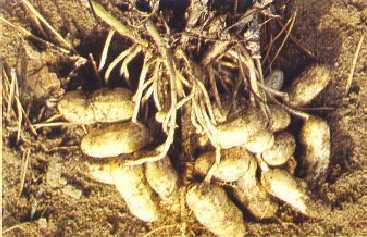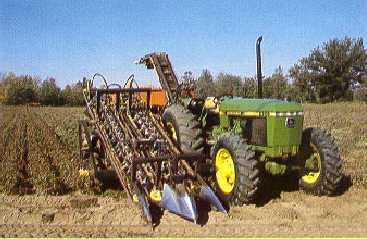Commercial peanut production in Ontario
Learn about best practices for producing high quality peanuts. This information is for commercial peanut farmers in Ontario.
Introduction
The peanut (Arachis hypogaea L.) is not a true nut. It is a heat loving legume plant belonging to the bean family. The plant is native to South America and is an important crop in many of the warmer regions of the world.
Peanuts come in 4 varieties:
- Valencia
- Spanish
- Virginia
- Runner
The Valencia and Spanish types are earlier maturing and the only ones suitable for the climate in Ontario. Currently, only varieties of the Valencia type are being commercially produced.
The peanut produces bright yellow flowers. The first flowers begin to appear around mid-June to early July. After pollination, the flower falls off and a shoot or peg, also known as a gynophore, begins to grow from the base of the flower, bends down and pushes into the soil. This process is often referred to as pegging. The peg grows 5 to 7.5 cm into the soil then turns to a horizontal position and matures into a peanut pod. Only the first 15 to 20 flowers develop into mature pods by season’s end. Even though the plant will continue flowering over a long period of time, those later developing pods will not have sufficient time to mature.

Area of adaptation
A minimum of 3,000 corn heat units are required for normal growth and development. Peanuts grown in areas with fewer heat units will not reach optimum maturity and generally the yield is too low to justify commercial production.
Soil type and fertilization
Peanuts grow best on light, well-drained sandy to sandy-loam soils. Soils that are imperfectly drained and those highly susceptible to wind erosion should be avoided. Heavier-textured soils that tend to pack and crust are less desirable because they may:
- reduce seedling emergence
- hamper pegging
- contribute to harvesting problems
Soils that contain stones are also undesirable. Peanut sized stones are of particular concern since they are difficult to separate from the peanuts.
Soils vary considerably in their ability to supply nutrients. A soil test is the best way to determine whether fertilizer or lime is required. Lime should be applied when the pH is below 5.8. In general, crops grown on soils having a good level of phosphate and potash have shown little response to a direct application of commercial fertilizer. However, if the soil test indicates that additional fertilizer is required, it should be broadcast and worked into the soil prior to seeding.
The peanut is a legume and has the ability to biologically fix its own nitrogen requirements. The seed must be properly inoculated at planting to encourage nodulation. Application of a granular (or liquid) inoculant (not a peat formulation) at the rate of 56 g per 100 m of row (9 kg/ha) is required. The inoculant must be applied directly on top of the seed in the seed furrow for good nodulation.
Peanuts require a large amount of readily available calcium at pegging. In some countries, Gypsum is applied at early bloom as the calcium source. However, no response has been obtained from applications of Gypsum in research trials.
Land preparation
To protect against wind and water erosion, sandy soils are normally seeded to a winter cover crop. This cover crop should be plowed down, and the soil packed by late April to allow ample time for crop decomposition prior to planting. Secondary tillage is carried out using a spring tooth or disk harrow just prior to planting.
The final seedbed must be smooth and preferably packed. Efficient once-over harvesting requires that every plant be picked up as close to the same height as possible so fields must be kept level.
Planting
Peanuts should be planted parallel to the direction of plowing to minimize undulation. The ideal time to plant peanuts is early to mid-May. If cold, wet weather conditions prevail, planting should be delayed. This crop, although not overly tolerant of cold temperatures, is more cold-hardy than traditionally grown beans and when emerged can withstand a spring frost.
Because peanut seed is extremely fragile, proper planter plates will be required to minimize damage. Any seed that splits will not grow. The planter should be equipped with depth bands, covering guards and press wheels for optimum seeding.
10 to 13 plants per m of row is considered optimum. To achieve this optimum stand, 13 to 16 good quality seeds should be planted per m of row. The seeds should be placed 4 to 5 cm deep in the soil and the rows should be spaced 60 to 75 cm apart.
Seed treatment
Seed treatment is desirable to control damping-off and other seed decay organisms but unfortunately, there are at present no registered materials for this use in Canada.
Varieties
The primary varieties grown in Ontario are:
- OAC Garroy
- OAC Ruby
- OAC Tango
These are Valencia type that mature a little earlier and are higher yielding than many U.S. varieties such as McRan, Valencia A and Valencia C.
Cultivation and weed control
The presence of weeds in the peanut crop can significantly reduce crop yield and make harvesting difficult. Weeds contribute to plugging of the pickup headers and carry additional soil into the machine. Herbicides are available that should provide control for most annual weeds. Perennial weeds in general, and particularly quackgrass, will not be controlled with presently registered peanut herbicides. Peanuts should not be planted in fields known to be infested with quackgrass.
Peanuts can be cultivated and, in some years, may require cultivation to control weed escapes. Cultivation should be shallow to prevent bringing up fresh untreated soil that will destroy the effects of the chemical herbicide treatment. When cultivating, care must be taken to ensure that fields remain level and free from ridges or hills.
Insect control
The potato leafhopper has been the main insect to cause significant losses to peanuts in Ontario. This insect is likely to appear during late June or early July. Leafhopper injury symptoms consist of a yellowing of the leaf tip and margins. Under severe injury conditions, a portion of the leaf may turn brown and fall off. Timing for control for potato leafhoppers is when an average of 2 to 3 nymphs per plant are observed. Some products may be registered for use.
Under dry weather conditions, mites have been known to attack the crop causing yield losses. The adult mite is tiny, rounded, eight-legged and usually red. Both the adults and immature mites feed on plant juices from the underside of the leaf. Their feeding causes yellowing, curling and bronzing. Close examination will reveal the mites and a fine webbing on the under surface of the leaves. U.S. data indicates that irrigation may help to alleviate this problem. Some products may be registered.
Disease control
Diseases have not been a problem on peanuts in Ontario. Ascochyta web blotch and Cercospora leaf spot have been identified but have not caused major crop losses. Pod rotting fungi have also been noted but are not considered a serious problem.
Irrigation
Peanuts respond to irrigation when dry weather conditions prevail at early flowering to pegging. An application of 2.5 cm of water is considered adequate to relieve the stress condition.
Harvesting
The optimum time for harvesting peanuts in Ontario is between September 20th and October 10th. Harvesting earlier than this is likely to lower the yield and quality while late harvesting may result in increased pod losses due to decay organism activity.
The peanut is not tolerant of a fall frost. A light frost is likely to only slightly reduce yield. A severe frost that kills the entire top growth necessitates commencement of harvest. If cold and wet conditions prevail after the killing frost, both quality and yield will be adversely affected. Available harvesting systems are:
- the once-over system
- the conventional U.S. system

The once over system involves the use of a Canadian built harvester. This machine undercuts the pods while belts grip the foliage to lift the plant from the soil. As the plants are being elevated, mechanical strippers remove the pods from the root mass. The peanuts fall to a collector belt, the trash is aspirated off, and the peanuts are conveyed to a hopper. Under wet harvesting conditions many Ontario producers are using some type of auxiliary cleaner (such as tumble washer) before curing to remove excess soil.
The U.S. system of harvesting involves either 2 or 3 operations to complete the harvest. First, a portion of the top growth must be removed. This can be accomplished using a rotary chopper. If a killing frost has already occurred, this step may not be necessary since most of the leaves will have already fallen off the plant. Next, the plants are dug and windrowed. During the digging and windrowing operation, plants are shaken slightly to remove soil. Plants should be left in the windrow long enough to allow some drying to occur. If plants are left in the windrow overnight and the temperature drops below freezing, damage will occur to the peanuts. The final step is combining using a specialized peanut combine which utilizes spring tooth cylinders to separate the pods from the rest of the plant.
Curing
The moisture content of the peanut must be reduced from the 60 to 70% normally present at the time of harvest to 10% for safe storage. Due to these conditions, peanuts should be cured using high air flow dryers equipped with supplemental heating capacity. Bulk tobacco kilns can be adapted for this purpose, but some minor modifications will be required. Special peanut drying wagons can also be used.

Air-movement, temperature and relative humidity all contribute to the resulting quality of the cured product.
Air flow
Harvested peanuts should be as clean as possible. Excessive soil and plant debris will result in uneven curing. The fan should be capable of moving a minimum of 500 L of air per second per m3 of peanuts.
Air temperature and relative humidity
The drying air temperature should be adjusted according to outside air conditions and should never exceed 30°C. Refer to Table 1.
| Outside air temperature (°C) | Drying temperature °C at 100% relative humidity | Drying temperature °C at 80% relative humidity | Drying temperature °C at 60% relative humidity | Drying temperature °C at 40% relative humidity |
|---|---|---|---|---|
| 5 | 19 | 17 | 15 | 14 |
| 10 | 21 | 19 | 17 | 15 |
| 15 | 24 | 22 | 29 | 17 |
| 20 | 28 | 25 | 22 | 20 |
| 25 | 30 | 28 | 25 | 25 |
Source: Mechanical Peanut Curing. North Carolina Agriculture Extension Service. Folder Number PPG20.
One way to use Table 1 would be to determine the outside air conditions by listening to local weather reports or by use of a sling psychrometer.
Assuming that the outside air is 5°C and 80% relative humidity, the maximum drying air temperature would be 17°C.
Increasing the drying air temperature above that suggested in Table 1 will result in faster drying since the relative humidity of the drying air is lower. However, peanuts cured under these conditions may have a greater proportion of off-flavors and poor milling characteristics. Peanuts cured at lower temperatures than those suggested in Table 1 could develop moulds and sprouts which result in off-flavors and poor appearance.
Marketing
Anyone contemplating peanut production should give careful consideration to marketing. At the present time, the only alternative is to contract with a local sheller. Since there is no guarantee that additional peanuts will be required in any given year, arrangements should be made prior to planting the crop.